Huis Ten Bosch is a theme park in Nagasaki, Japan that recreates 17th-century Holland with real-size replicas of Dutch buildings, including Palace Huis Ten Bosch, built with royal permission. The park features canals, windmills, amusement rides, and shops, surrounded by greenery and forests, with a marina and residential area.
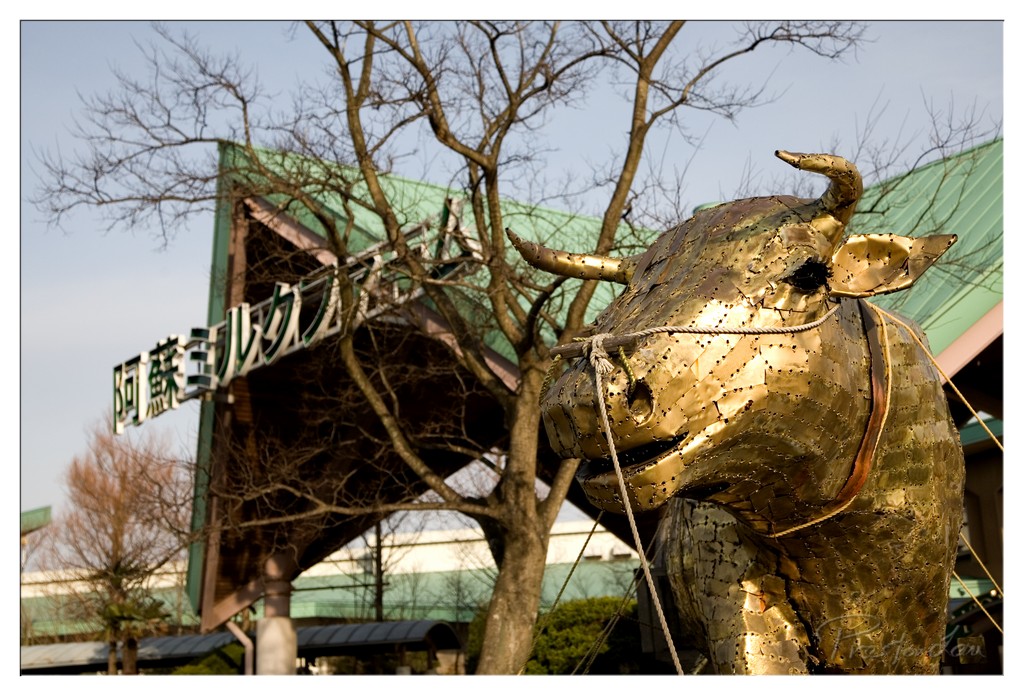

1. Overall Rating (0–10) — 7.0
This photograph captures a striking juxtaposition of industrial artistry and cultural signage, centered on a textured golden bull sculpture that commands attention with its metallic sheen and intricate construction. The golden hue of the bull contrasts beautifully with the bare winter branches and the muted green roof behind it, lending a quiet dignity to the scene. While the composition is strong, the slightly cluttered background and modest framing prevent it from achieving full visual harmony, but the image remains compelling through its layered narrative of craftsmanship and place.
2. Composition (0–10) — 6.5
The bull is placed off-center, drawing the eye diagonally across the frame, which creates dynamic tension. However, the overhanging sign and tree branches slightly distract from the subject, creating visual clutter that weakens the overall balance.
3. Lighting (0–10) — 7.5
The soft, directional light from the side enhances the texture of the metal sculpture, creating subtle highlights and shadows that emphasize its riveted surface. The clear sky provides a neutral backdrop, allowing the golden tones to stand out without harsh glare.
4. Color & Tone (0–10) — 7.0
The warm gold of the bull contrasts effectively with the cool green roof and pale sky, creating a balanced yet vibrant palette. The tones are well-saturated without appearing unnatural, giving the image a slightly cinematic quality.
5. Creativity (0–10) — 7.5
The choice to focus on a sculptural representation of a bull—possibly symbolizing strength or local heritage—combined with the Japanese signage, suggests a narrative rooted in cultural identity. The juxtaposition of art, nature, and architecture adds depth and invites interpretation.
6. Technical Quality (0–10) — 8.0
The image is sharp and well-focused, particularly on the bull’s head and face. The depth of field is appropriately managed, with the background slightly blurred to keep attention on the main subject.
7. Emotional Impact (0–10) — 6.5
There is a sense of quiet reverence for the craftsmanship of the sculpture, and the bare trees suggest a transitional season, adding a contemplative mood. While the image is visually engaging, it stops short of evoking a strong emotional response, remaining more observational than deeply moving.
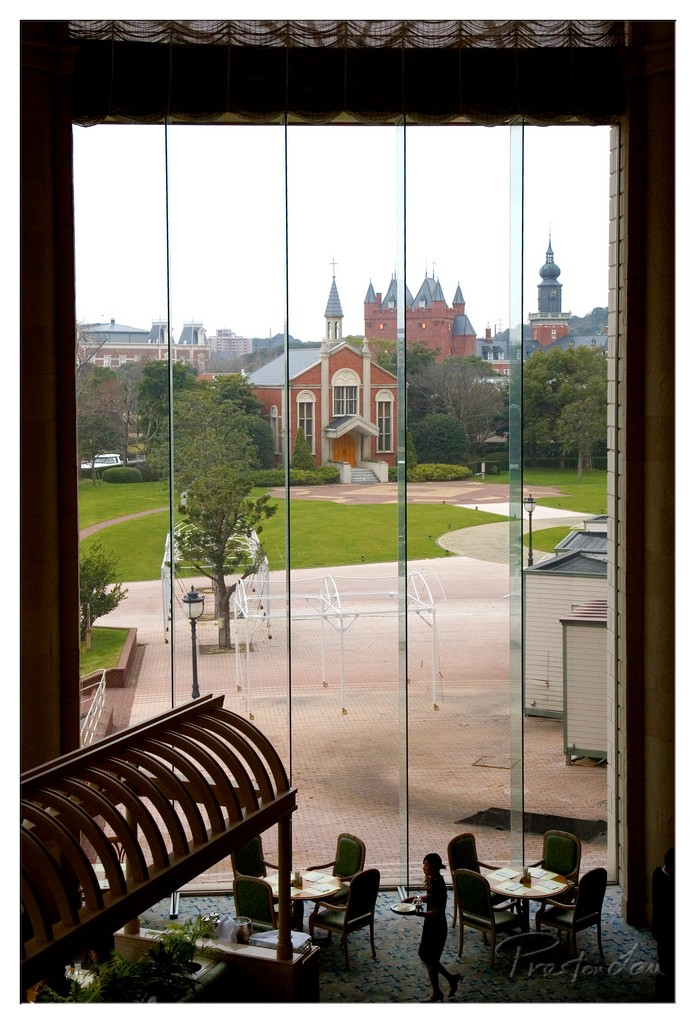

1. Overall Rating (0–10) — 7.0
This photograph captures a serene and contemplative moment, where the interior of a refined space opens onto a picturesque view of a European-style church and manicured grounds. The juxtaposition of the elegant interior—featuring warm wood and soft lighting—with the expansive, slightly overcast landscape creates a sense of quiet observation and cultural richness. While the composition is strong, the muted tones and flat lighting slightly dampen the visual energy, leaving the image feeling more like a captured memory than a compelling narrative.
2. Composition (0–10) — 7.5
The framing through the glass panes creates a layered, almost theatrical effect, with the interior elements—stairs, tables, and a server—anchoring the foreground. The central alignment of the church draws the eye naturally, while the vertical lines of the glass divide the view into balanced sections, enhancing the sense of order and depth.
3. Lighting (0–10) — 5.5
The diffuse, overcast light softens the scene, reducing contrast and casting a neutral, almost somber mood. While this suits the calm atmosphere, it also flattens the textures and diminishes the richness of the red brick and green lawns.
4. Color & Tone (0–10) — 6.0
The palette is restrained, dominated by muted earth tones and soft grays, with the red brick of the church providing a subtle focal point. The lack of vibrancy gives the image a subdued, documentary feel, though the tonal balance remains harmonious.
5. Creativity (0–10) — 7.0
The choice to photograph from inside, looking out, introduces a narrative layer—observing a world from a place of comfort and quiet. The reflection of the interior on the glass and the human figure in motion add a sense of life and time, elevating the image beyond a simple landscape.
6. Technical Quality (0–10) — 7.5
The image is sharp and well-focused, with clear detail in both the foreground and background. The vertical seams of the glass are visible but do not detract from the overall clarity, and the exposure is well-managed despite the overcast conditions.
7. Emotional Impact (0–10) — 6.5
The image evokes a sense of calm and introspection, inviting the viewer to pause and reflect. The solitary figure and expansive view create a quiet melancholy, suggesting a moment suspended in time—peaceful, yet slightly wistful.
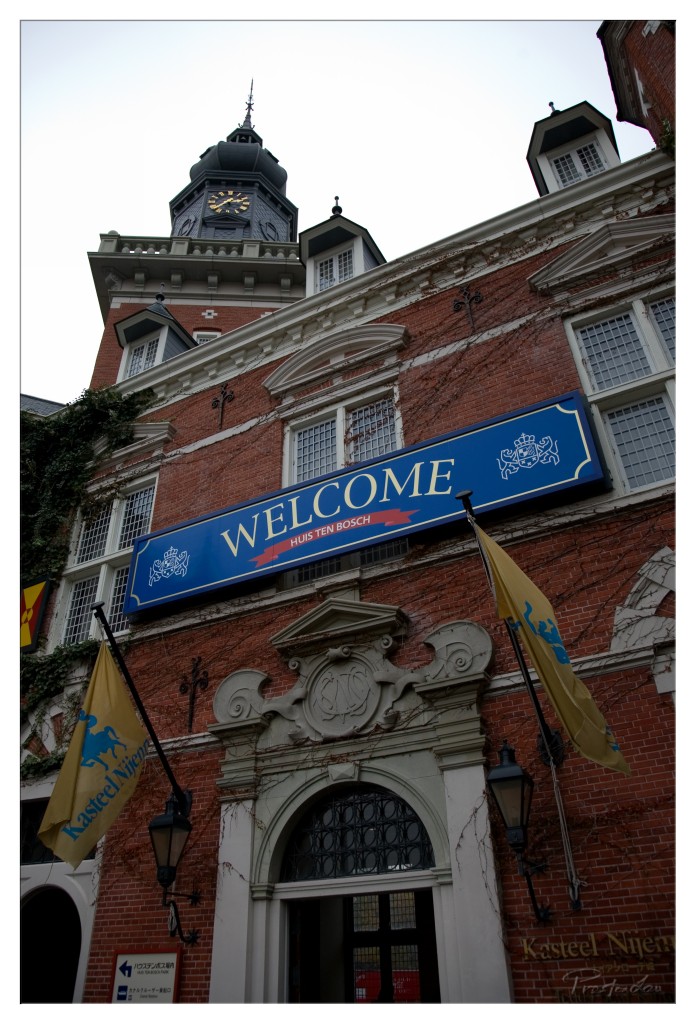

1. Overall Rating (0–10) — 6.8
This photograph captures the historic charm of Huis ten Bosch with a sense of architectural gravitas, where the grandeur of the brick façade and ornate details evoke a story of Dutch heritage. The low-angle perspective emphasizes the building’s imposing presence, though the overcast sky and slightly muted colors temper its visual drama. While the image succeeds in documenting the site with clarity, it lacks the emotional resonance or dynamic lighting to elevate it beyond a straightforward architectural record.
2. Composition (0–10) — 6.5
The low-angle shot creates a dramatic upward view, emphasizing the building’s height and architectural detail. The central placement of the "WELCOME" sign and the arched entrance provide a strong focal point, but the framing feels slightly unbalanced due to the asymmetrical placement of the flags and the dense foliage on the left.
3. Lighting (0–10) — 5.5
The soft, diffused light from the overcast sky eliminates harsh shadows and allows for even exposure across the façade. However, the lack of strong directional light results in a flat appearance, diminishing the texture and depth of the brickwork and ornate stonework.
4. Color & Tone (0–10) — 6.0
The dominant red of the brick contrasts effectively with the blue sign and white trim, creating a visually cohesive palette. The overall tone is slightly cool and subdued, which aligns with the overcast conditions, but the colors lack vibrancy, slightly dampening the scene’s visual appeal.
5. Creativity (0–10) — 6.5
The choice of a low-angle perspective adds a sense of monumentality, and the inclusion of the "WELCOME" sign and flags grounds the image in its cultural context. While the approach is straightforward, the composition and framing reflect a deliberate effort to convey both the architectural and narrative significance of the site.
6. Technical Quality (0–10) — 7.0
The image is sharp and well-focused, with clear details in the brickwork, signage, and decorative elements. The exposure is balanced, and there is minimal noise, indicating strong technical execution despite the challenging lighting conditions.
7. Emotional Impact (0–10) — 6.0
The photograph conveys a quiet sense of reverence for history and tradition, inviting the viewer to appreciate the building’s legacy. However, the lack of dynamic lighting and emotional contrast keeps the mood subdued, limiting the image’s ability to deeply engage or inspire.
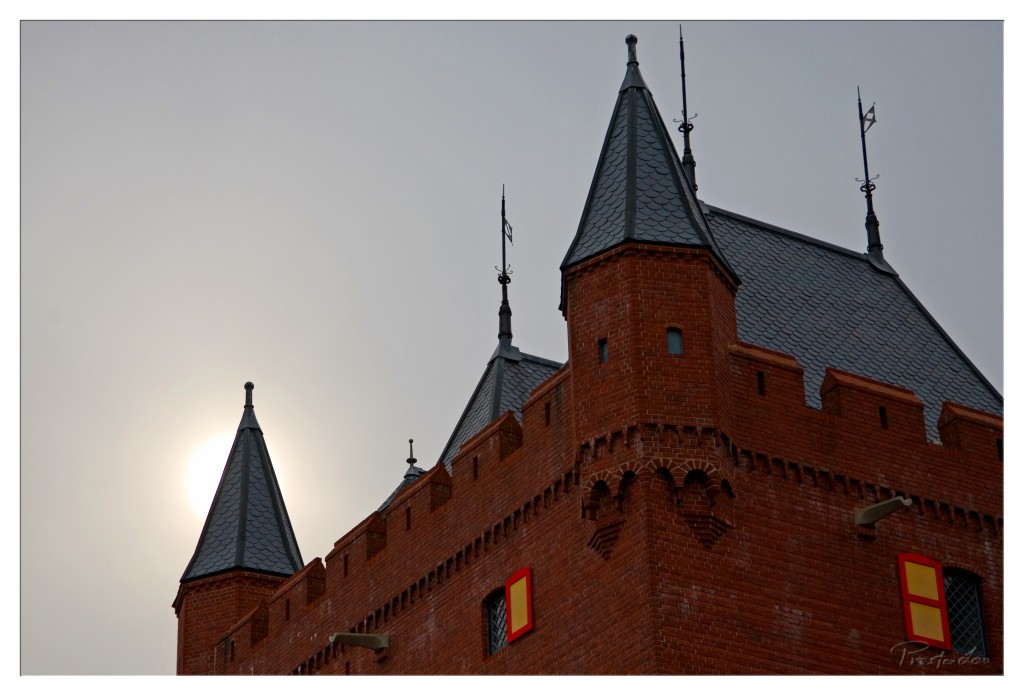

1. Overall Rating (0–10) — 7.0
This photograph captures the imposing silhouette of a brick castle under a moody, overcast sky, where the low sun creates a dramatic backlighting effect. The warm glow of the sun behind the structure enhances the texture of the red brick and the sharp lines of the spires, lending a timeless, almost cinematic quality. While the image is visually compelling, the flatness of the sky and the slightly muted tones prevent it from achieving greater depth and emotional resonance.
2. Composition (0–10) — 7.5
The diagonal placement of the castle’s towers creates a dynamic visual flow, drawing the eye from the lower left to the upper right. The inclusion of the sun as a soft glow on the left balances the composition, while the framing emphasizes the architectural grandeur.
3. Lighting (0–10) — 8.0
The backlighting from the sun creates a striking silhouette effect, highlighting the castle’s form against the pale sky. The soft, diffused light enhances the texture of the brickwork and adds a sense of mystery and atmosphere.
4. Color & Tone (0–10) — 6.5
The warm tones of the brick contrast with the cool gray sky, creating a balanced palette. However, the overall color temperature is slightly flat, and the lack of vibrant saturation limits the visual impact.
5. Creativity (0–10) — 7.0
The photographer captures a classic architectural subject with a contemplative, almost romantic mood. The use of backlighting and the inclusion of the sun as a compositional element demonstrate a thoughtful approach to storytelling through light.
6. Technical Quality (0–10) — 7.5
The image is sharp and clear, with fine detail visible in the brickwork and roof tiles. The exposure is well-managed, though the dynamic range could be expanded to preserve more detail in the highlights.
7. Emotional Impact (0–10) — 7.0
The photograph evokes a sense of quiet grandeur and nostalgia, inviting the viewer to imagine the history behind the castle. The soft light and muted tones contribute to a reflective, introspective mood.
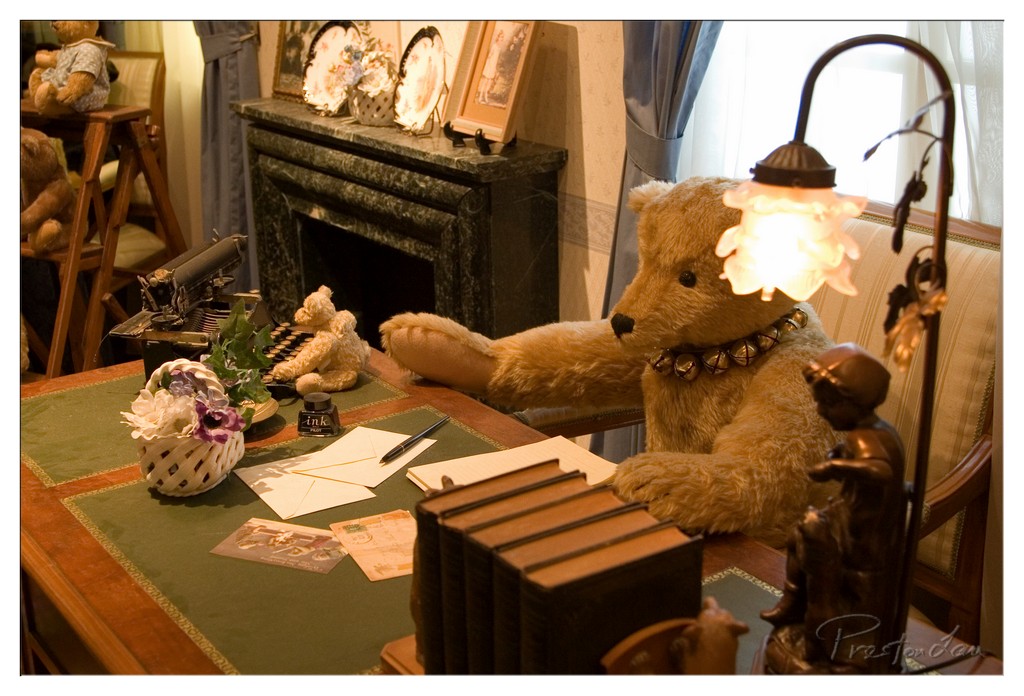

1. Overall Rating (0–10) — 7.5
This photograph masterfully evokes a sense of whimsical nostalgia, transforming a stuffed bear into a dignified scribe within a meticulously staged Victorian study. The warm, ambient glow of the lamp and the carefully arranged props—typewriter, books, and postcards—create a narrative of quiet creativity and timeless charm. While the scene feels slightly over-staged, the attention to detail and atmospheric lighting lend it a dreamlike quality that captivates the viewer.
2. Composition (0–10) — 8.0
The bear is positioned off-center, drawing the eye toward the typewriter and letter on the desk, while the diagonal lines of the lamp and books create dynamic flow. The depth is well-managed, with foreground elements framing the subject and background details adding context without distraction.
3. Lighting (0–10) — 9.0
The soft, directional glow from the lamp creates a warm, intimate atmosphere, casting gentle shadows that enhance texture and depth. The light beautifully highlights the bear’s fur and the desk’s surface, while the natural light from the window balances the scene without overpowering the focal point.
4. Color & Tone (0–10) — 8.0
The palette is rich and cohesive, dominated by warm browns, creams, and muted greens that evoke a vintage aesthetic. The contrast between the warm lamp light and the cooler tones of the background creates visual interest while maintaining a harmonious, nostalgic tone.
5. Creativity (0–10) — 9.0
The image is highly imaginative, blending whimsy with realism to tell a quiet story of a bear engaged in literary pursuits. The concept is original and executed with care, transforming a simple toy into a character with personality and purpose.
6. Technical Quality (0–10) — 8.0
Sharp focus on the bear and desk elements ensures clarity, while the depth of field effectively isolates the subject. The exposure is well-balanced, with no harsh highlights or lost shadows, showcasing fine detail throughout the frame.
7. Emotional Impact (0–10) — 8.5
The photograph elicits a sense of warmth, nostalgia, and gentle wonder, inviting the viewer to imagine the bear’s thoughts and stories. The combination of soft lighting, rich textures, and storytelling elements creates a deeply resonant and emotionally engaging experience.
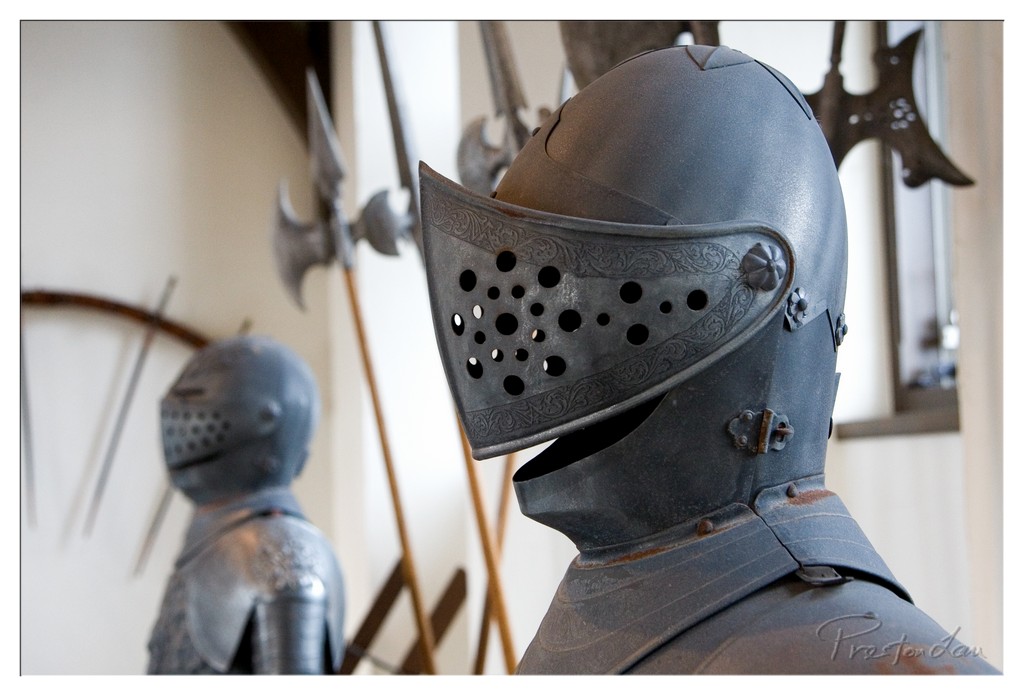

1. Overall Rating (0–10) — 7.5
This photograph captures the imposing presence of medieval armor with a sense of quiet authority, where the texture and craftsmanship of the helmet become the focal point. The shallow depth of field isolates the foreground helmet, creating a dramatic contrast between the detailed, weathered metal and the softly blurred background of weapons and another suit of armor. While the image succeeds in evoking a historical atmosphere, its muted lighting and restrained color palette slightly limit its emotional punch, leaving room for greater atmospheric richness.
2. Composition (0–10) — 7.0
The composition uses a strong diagonal arrangement, with the helmet positioned slightly off-center to draw the eye toward its intricate details. The blurred background figures and weapons provide context without distracting, though a tighter crop might enhance focus and visual weight.
3. Lighting (0–10) — 6.5
Soft, diffused light from the side highlights the helmet’s contours and engravings, creating subtle shadows that emphasize texture. However, the lighting lacks dynamic contrast, resulting in a somewhat flat appearance that diminishes the sense of depth.
4. Color & Tone (0–10) — 6.0
The palette is dominated by cool, metallic grays and muted tones, which suit the subject but feel slightly desaturated. A touch more warmth or contrast in the highlights could add visual interest and evoke the aged patina of the armor more vividly.
5. Creativity (0–10) — 7.0
The choice to focus on the helmet’s intricate details while blurring the surrounding artifacts creates a narrative of individuality within a larger historical context. The use of shallow depth of field transforms a museum display into a contemplative portrait of a warrior’s legacy.
6. Technical Quality (0–10) — 8.0
The image is sharp on the helmet, with precise focus and clean detail visible in the metalwork. The background blur is smooth and controlled, indicating careful use of aperture and lens choice.
7. Emotional Impact (0–10) — 6.5
The photograph conveys a solemn reverence for the past, with the stillness of the armor evoking a sense of silent history. While the mood is contemplative, the lack of dramatic lighting and color prevents a deeper emotional connection, leaving the viewer observing rather than feeling.
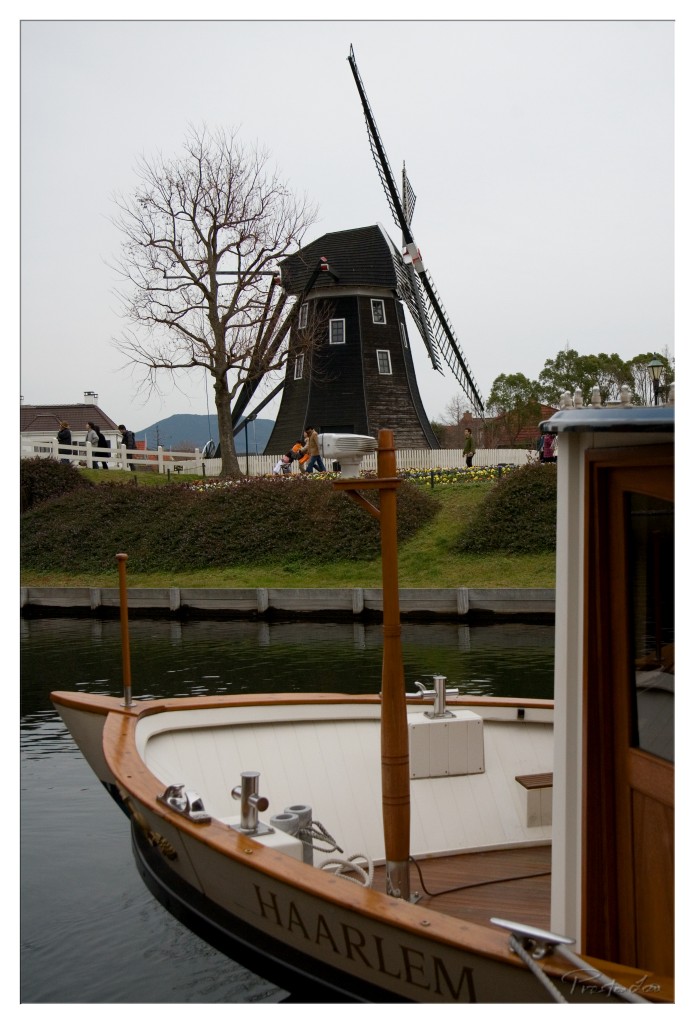

1. Overall Rating (0–10) — 6.8
This photograph captures a serene, almost postcard-like scene of a traditional Dutch windmill and a canal boat, evoking a sense of cultural authenticity and quiet charm. The composition draws the eye from the boat in the foreground to the windmill in the distance, creating a layered narrative of travel and place. While the muted weather and slightly overcast sky temper the vibrancy of the scene, the image succeeds in conveying a tranquil, reflective mood that feels both picturesque and grounded.
2. Composition (0–10) — 7.0
The boat in the foreground provides a strong anchor, leading the viewer’s gaze toward the windmill and the people in the midground. The diagonal lines of the boat and the windmill’s sails create visual tension and movement, while the white fence and greenery add depth and structure. The framing feels slightly tight, but the layered elements work well together to create a balanced and engaging scene.
3. Lighting (0–10) — 5.5
The overcast sky results in soft, diffused light that minimizes harsh shadows and evenly illuminates the scene. While this creates a calm and neutral atmosphere, it also reduces contrast and depth, giving the image a somewhat flat appearance. The lack of directional sunlight limits the dramatic potential of the light, though it suits the tranquil mood.
4. Color & Tone (0–10) — 6.0
The palette is subdued, dominated by earthy browns, muted greens, and soft grays, which reflect the cloudy weather and the natural materials of the scene. The dark wood of the windmill and boat provide visual anchors, while the white trim and railing offer subtle contrast. The color temperature leans cool, enhancing the quiet, contemplative tone, but could benefit from a touch more warmth to invigorate the image.
5. Creativity (0–10) — 7.0
The image captures a recognizable cultural motif—Dutch windmills and canal boats—but does so with a thoughtful composition that emphasizes perspective and depth. The inclusion of the “HAARLEM” inscription on the boat adds a layer of specificity and storytelling, grounding the scene in a particular place. While the subject is familiar, the framing and layering lend it a sense of narrative and personal observation.
6. Technical Quality (0–10) — 7.5
The image is sharp and clear, with fine detail visible in the boat’s trim, the windmill’s structure, and the surrounding foliage. The focus is well-managed, with the boat in the foreground and the windmill in the background both rendered with clarity. The exposure is balanced, with no significant areas of over- or underexposure, though the overall contrast is modest.
7. Emotional Impact (0–10) — 6.5
The photograph evokes a sense of peaceful nostalgia and quiet contemplation, inviting the viewer to imagine a leisurely canal ride through a historic Dutch village. The presence of people near the windmill adds a human touch, suggesting life and continuity, while the bare tree and gray sky lend a touch of melancholy. The emotional resonance is gentle and reflective, resonating with those who appreciate cultural landscapes and quiet moments.
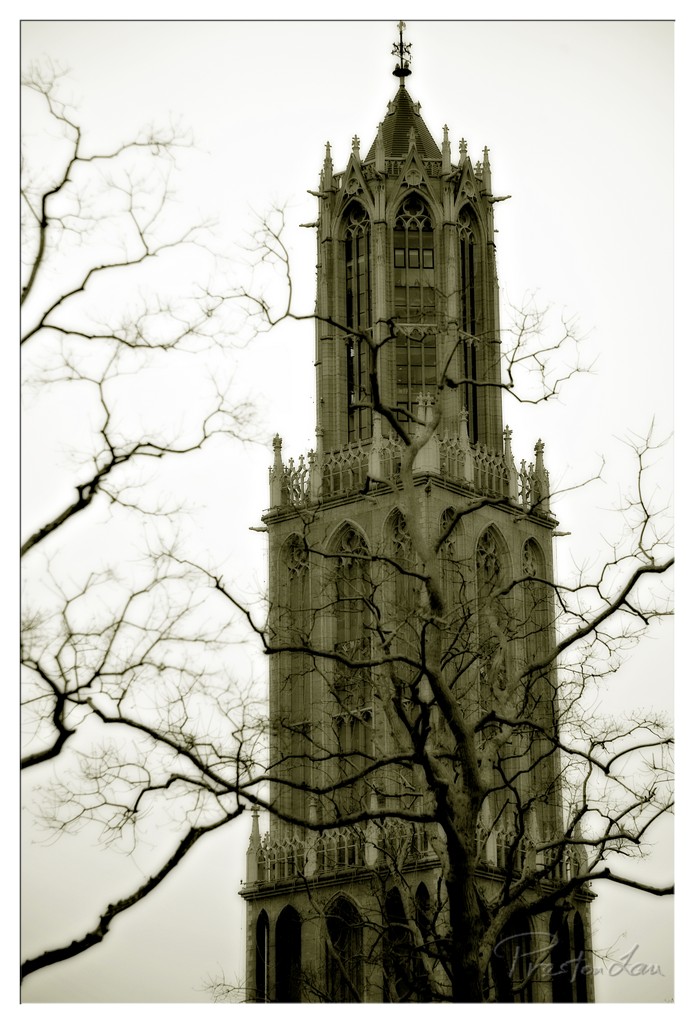

1. Overall Rating (0–10) — 7.5
This photograph captures the solemn grandeur of a Gothic spire, framed by the skeletal branches of a winter tree in a masterful blend of architecture and nature. The sepia tone lends a timeless, almost nostalgic quality, enhancing the sense of history and stillness. While the image is visually compelling, its emotional depth is slightly restrained by a lack of dynamic contrast and a somewhat static composition that keeps the viewer at a distance.
2. Composition (0–10) — 7.0
The low-angle perspective emphasizes the tower’s verticality, while the intersecting branches create a natural, organic frame that draws the eye upward. However, the symmetry is slightly off-center, and the branches occupy too much of the foreground, creating visual clutter that competes with the main subject.
3. Lighting (0–10) — 6.0
The diffuse, overcast light softens the scene, minimizing harsh shadows and emphasizing texture in the stonework. While the lighting is even and appropriate for the mood, it lacks depth and dimension, contributing to a somewhat flat appearance.
4. Color & Tone (0–10) — 8.0
The sepia toning is highly effective, unifying the image with a cohesive, vintage aesthetic that enhances the historical feel. The limited palette strengthens the mood, though the absence of color limits the visual richness.
5. Creativity (0–10) — 8.0
The choice to frame the tower through bare branches is original and evocative, creating a dialogue between the natural and the man-made. The artistic use of toning and perspective demonstrates a strong sense of intention and vision.
6. Technical Quality (0–10) — 7.5
The image is sharp and clear, with well-preserved detail in both the tower and the branches. The focus is consistent, and the post-processing is clean, though the image lacks the tonal range to fully exploit its potential.
7. Emotional Impact (0–10) — 7.0
The photograph evokes a contemplative, wistful mood, suggesting themes of time, endurance, and quiet beauty. While the emotional resonance is strong, the restrained lighting and composition keep the experience more intellectual than visceral.
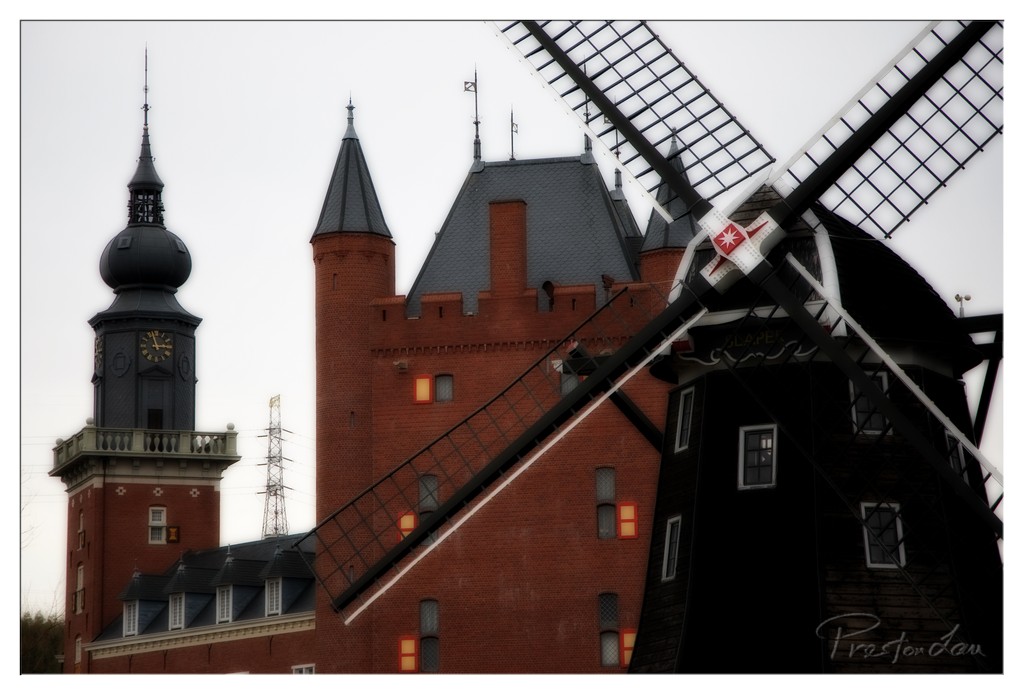

1. Overall Rating (0–10) — 7.0
This photograph captures a striking juxtaposition of historical Dutch architecture and a windmill, evoking a sense of timeless tradition under a moody sky. The bold diagonal of the windmill blades contrasts with the vertical lines of the clock tower, creating a dynamic visual rhythm. While the image successfully conveys atmosphere, the heavy processing slightly flattens the natural textures, and the composition feels more like a snapshot than a fully realized artistic statement.
2. Composition (0–10) — 7.0
The diagonal sweep of the windmill blades creates a strong visual path, drawing the eye across the frame. The clock tower and brick building anchor the left side, balancing the weight of the mill on the right. However, the framing cuts off the top of the windmill slightly, and the tight crop feels less intentional than expansive.
3. Lighting (0–10) — 5.5
The overcast sky produces soft, diffused light, which minimizes harsh shadows and allows for even exposure across the scene. However, the lack of directional light flattens the depth of the brickwork and gives the image a muted, almost melancholic tone that feels over-processed.
4. Color & Tone (0–10) — 6.5
The palette is dominated by deep reds, blacks, and grays, creating a somber, almost cinematic mood. The saturation appears enhanced, especially in the glowing windows, which stand out against the muted background. While the color choices are deliberate, they verge on artificial, reducing the authenticity of the scene.
5. Creativity (0–10) — 7.5
The combination of the windmill and the castle-like structure offers a compelling narrative of Dutch heritage. The low-angle perspective and framing emphasize scale and grandeur, while the selective lighting on the windows adds a touch of mystery. The image feels like a stylized interpretation rather than a straightforward documentary shot.
6. Technical Quality (0–10) — 7.5
The image is sharp and well-focused, with clear detail in the brickwork and mill structure. The digital signature is cleanly placed, and the exposure is balanced despite the flat lighting. Minor noise is present in the darker areas, but it does not detract significantly from the overall clarity.
7. Emotional Impact (0–10) — 6.5
The photograph evokes a quiet nostalgia, suggesting stories of centuries past. The interplay of light and shadow, especially in the lit windows, hints at human presence within the historic architecture. While the mood is strong, the heavy tonal adjustments distance the viewer, making the emotional connection feel slightly filtered.
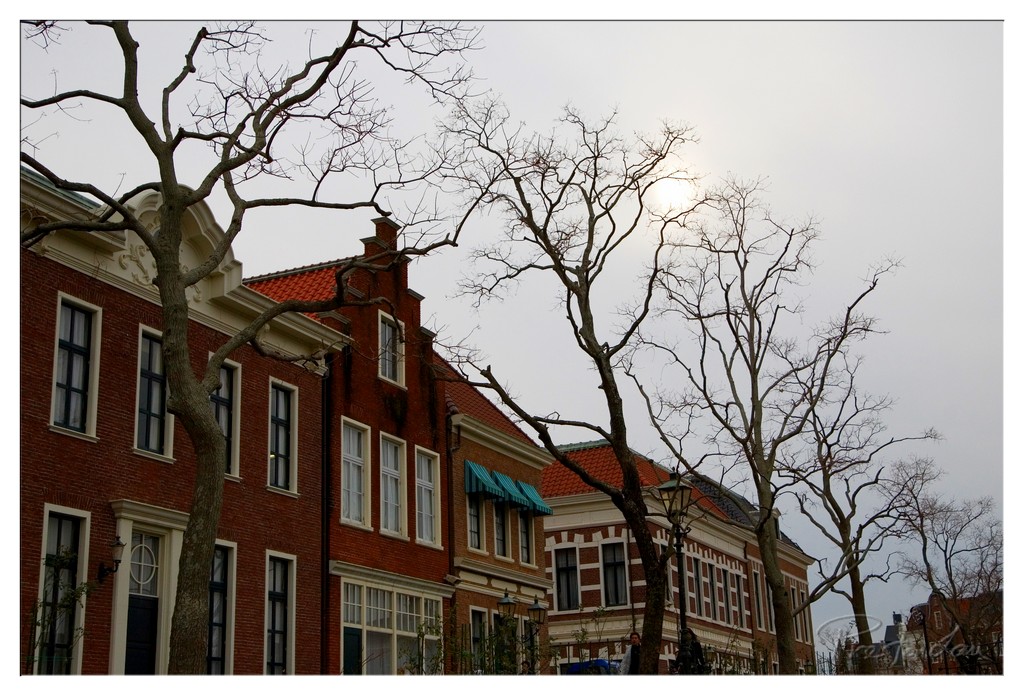

1. Overall Rating (0–10) — 7.0
This photograph captures a quiet, contemplative moment in a European-style town, where bare winter trees frame historic brick buildings under a soft, overcast sky. The interplay of light and shadow through the branches creates a delicate, almost melancholic atmosphere, while the muted tones and architectural details lend a sense of timelessness. While the image is visually restrained and atmospheric, it occasionally lacks the visual punch needed to fully engage the viewer, holding back from its full emotional potential.
2. Composition (0–10) — 7.0
The diagonal lines of the bare trees create a dynamic entry into the frame, guiding the eye across the row of buildings. The placement of the sun behind the branches adds a subtle backlighting effect, enhancing depth. However, the slight asymmetry and the inclusion of a faint watermark in the lower right distract from the visual harmony.
3. Lighting (0–10) — 6.5
The soft, diffused light of an overcast day creates a gentle glow, with the sun peeking through the branches as a subtle focal point. While the lighting is natural and moody, it lacks strong contrast, resulting in a somewhat flat appearance that diminishes the texture of the brickwork and tree limbs.
4. Color & Tone (0–10) — 6.0
The palette is subdued, dominated by earthy reds of the brick, pale grays of the sky, and dark silhouettes of the trees. The overall tonal range is narrow, with a slight cool cast that enhances the wintery feel but limits vibrancy. The green awning offers a small, but effective, pop of color.
5. Creativity (0–10) — 6.5
The image leverages natural elements—bare branches and diffused light—to create a poetic, almost painterly scene. The choice to include the sun as a soft glow through the branches adds a layer of quiet beauty, suggesting a moment of transition between seasons. While not overtly experimental, the composition reflects a thoughtful approach to urban landscape photography.
6. Technical Quality (0–10) — 7.5
The image is sharp and well-focused, with clear detail visible in both the buildings and the intricate patterns of the tree branches. The exposure is balanced, with no significant overexposed or underexposed areas. The watermark, though subtle, slightly detracts from the clean presentation.
7. Emotional Impact (0–10) — 6.5
The photograph evokes a sense of stillness and introspection, capturing a quiet winter day with a gentle melancholy. The absence of people and the bare trees suggest solitude and the passage of time, inviting the viewer to pause and reflect. While the mood is well-conveyed, the emotional resonance is restrained by the muted tonality and lack of strong narrative focus.
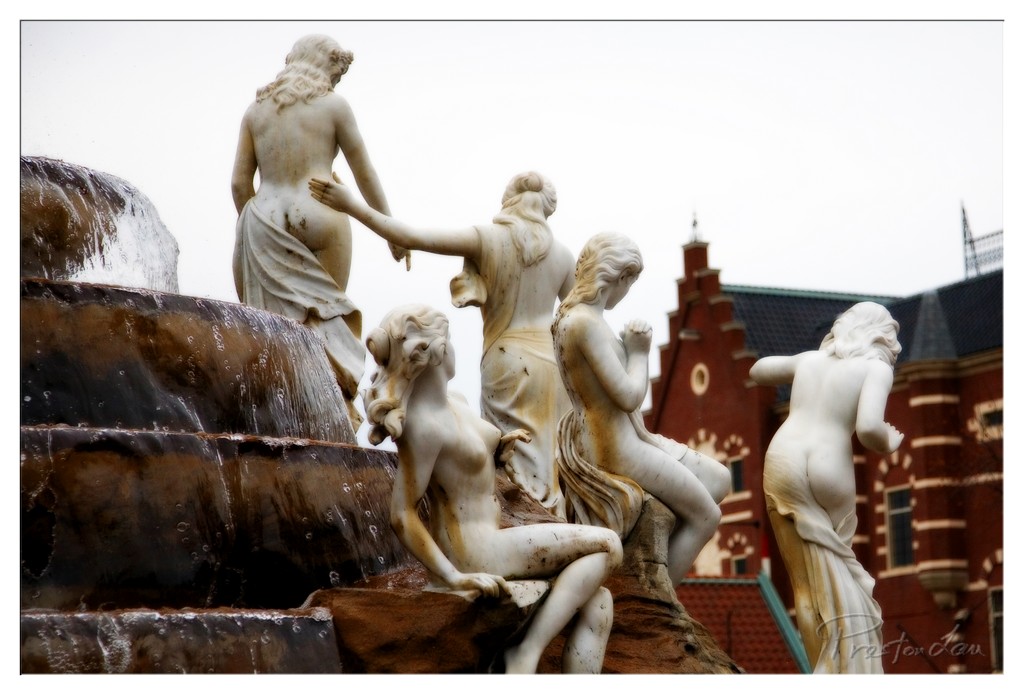

1. Overall Rating (0–10) — 7.0
This photograph captures a dramatic interplay between classical sculpture and urban architecture, where the fluidity of the figures contrasts with the rigid lines of the brick building behind. The statues, weathered and draped in the soft glow of overcast light, convey a sense of timelessness and melancholy, while the cascading water adds movement and texture. Though the image is compelling in mood, its technical execution—particularly in lighting and color balance—holds it back from true visual elegance.
2. Composition (0–10) — 7.5
The statues are arranged diagonally across the frame, guiding the eye from the waterfall on the left to the figures and finally to the red building on the right. The low angle enhances the grandeur of the sculptures, though the inclusion of the building slightly disrupts the classical harmony.
3. Lighting (0–10) — 6.0
The overcast sky produces soft, diffused light that minimizes harsh shadows and highlights the textures of the marble. However, the lack of directional light results in a flatness that diminishes the three-dimensionality of the figures.
4. Color & Tone (0–10) — 6.5
The muted tones of the marble and the subdued red of the building create a restrained palette. The overall coolness of the image, combined with the lack of vibrancy, gives it a somber, almost washed-out quality that tempers the potential drama.
5. Creativity (0–10) — 7.0
The juxtaposition of classical sculpture with a modern brick structure introduces an intriguing narrative layer—of history, decay, and urban context. The choice to include the building as a framing element, rather than a distraction, shows thoughtful intent.
6. Technical Quality (0–10) — 7.5
The image is sharp and well-focused, particularly on the central figures, with the water motion captured clearly. The watermark is subtle and does not detract from the composition.
7. Emotional Impact (0–10) — 7.0
The photograph evokes a contemplative, almost poetic mood—of beauty preserved in decay, of human form frozen in time. The viewer is drawn into a quiet reflection on permanence and change, though the muted colors slightly dampen the emotional resonance.
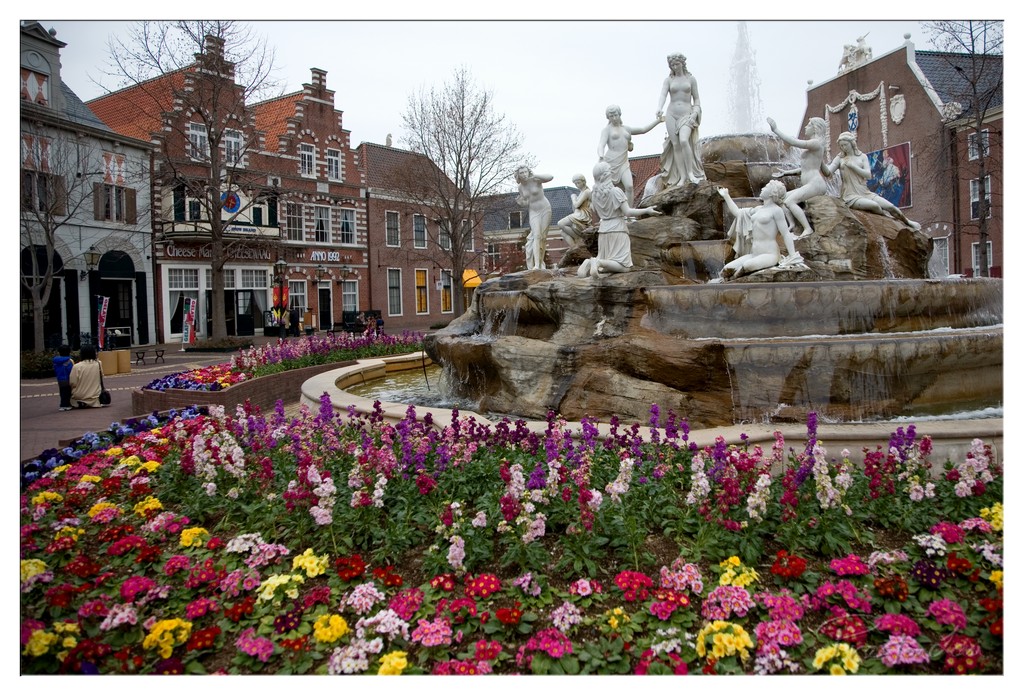

1. Overall Rating (0–10) — 7.0
This photograph captures a vibrant urban square where classical artistry meets lively horticulture, creating a harmonious blend of cultural heritage and natural beauty. The fountain’s sculptural grandeur is beautifully framed by a riot of colorful flowers, while the Dutch-style architecture in the background grounds the scene in place and time. While the overcast sky tempers the mood with a soft neutrality, the image succeeds in conveying a sense of placid celebration—both of art and of community life.
2. Composition (0–10) — 7.5
The low-angle perspective emphasizes the flowerbed in the foreground, drawing the viewer’s eye upward toward the fountain and the surrounding buildings. The diagonal sweep of the flowerbed creates dynamic movement, while the central placement of the fountain establishes visual balance. The inclusion of the people on the left adds scale and life without disrupting the composition.
3. Lighting (0–10) — 6.0
The overcast sky produces soft, diffused light that evenly illuminates the scene, minimizing harsh shadows and allowing rich details in both the flowers and the stone sculptures. However, the lack of strong directional light or contrast slightly diminishes the image’s depth and drama.
4. Color & Tone (0–10) — 8.0
The vivid, saturated hues of the flowers—ranging from deep purples to bright yellows—create a striking contrast against the muted tones of the stone and brick. The cool, neutral palette of the background enhances the warmth and vibrancy of the floral foreground, giving the image a lively yet cohesive color story.
5. Creativity (0–10) — 7.0
The image blends documentary realism with artistic framing, using the flowerbed as a natural border to highlight the fountain’s sculptural narrative. The juxtaposition of natural and man-made elements—flowers and statues—invites contemplation on the interplay between nature and culture, lending the photograph a thoughtful, layered quality.
6. Technical Quality (0–10) — 8.0
The photograph is sharp and well-focused throughout, with fine detail visible in both the flowers and the intricate carvings of the statues. The exposure is balanced, and the depth of field is appropriately managed to keep both foreground and background elements clear.
7. Emotional Impact (0–10) — 7.5
The scene evokes a sense of peaceful delight and civic pride, inviting the viewer to imagine strolling through this picturesque square. The combination of art, nature, and community life fosters a warm, welcoming atmosphere that feels both timeless and alive.
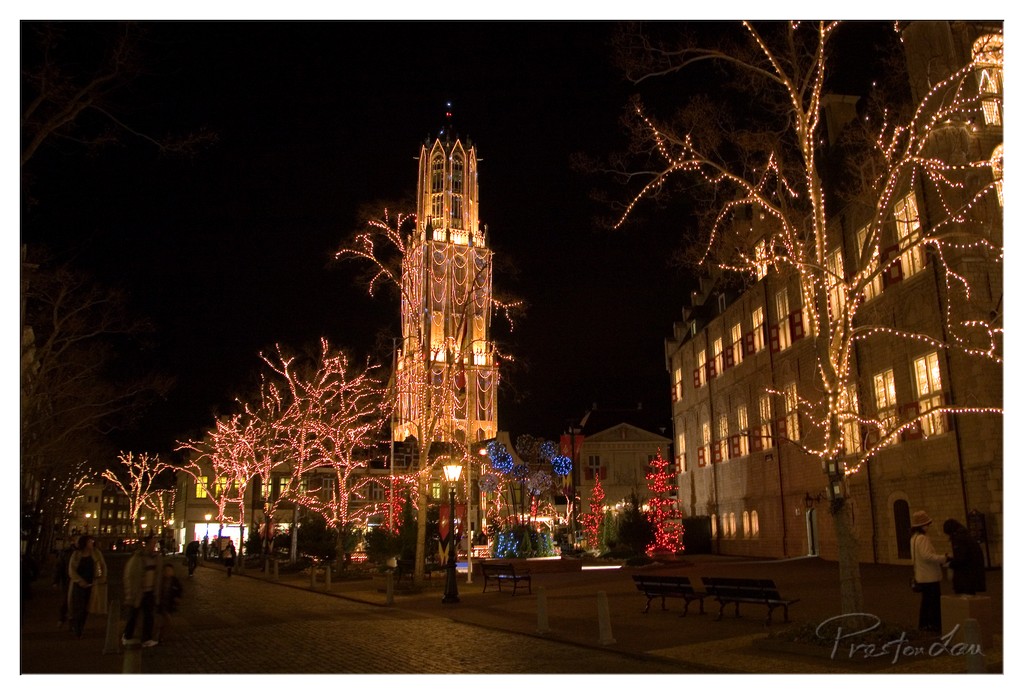

1. Overall Rating (0–10) — 7.5
This photograph captures the enchanting glow of a European town at night, where the historic church tower stands as a luminous centerpiece amid a festive winter scene. The warm string lights on the bare trees and buildings create a cozy, celebratory atmosphere, while the dark sky enhances the brilliance of the illumination. The image successfully blends architectural grandeur with seasonal charm, though the slightly cluttered foreground and low contrast in the shadows temper its visual elegance.
2. Composition (0–10) — 7.0
The tall church tower is well-centered and draws the eye upward, creating a strong vertical anchor. The leading lines of the cobblestone path and the arrangement of trees guide the viewer’s gaze into the scene, though the presence of pedestrians and benches on the left slightly disrupts the symmetry and flow.
3. Lighting (0–10) — 8.0
The interplay of warm artificial lights against the deep night sky creates a dramatic and inviting mood. The tower’s illumination highlights its intricate details, while the string lights on the trees add texture and rhythm. The lighting is well-balanced, with no harsh overexposed areas, though the lower-left portion is slightly underlit.
4. Color & Tone (0–10) — 7.5
The dominant warm tones of gold and red from the lights evoke a festive and intimate atmosphere. The cool blue accents on the central decorations offer a subtle contrast, adding visual interest. The overall tone is rich and harmonious, though the deep shadows limit the visibility of color in certain areas.
5. Creativity (0–10) — 7.0
The photographer captures a classic holiday scene with a strong sense of place and atmosphere. The use of light as a storytelling device is effective, and the composition conveys a narrative of community and celebration. While the concept is familiar, the execution feels thoughtful and evocative.
6. Technical Quality (0–10) — 8.0
The image is sharp and well-focused, particularly on the tower and the foreground trees. The long exposure is controlled, minimizing motion blur from the people while maintaining clarity. The watermark is subtle and does not distract.
7. Emotional Impact (0–10) — 8.0
The photograph evokes a sense of wonder and nostalgia, reminiscent of a quiet winter evening in a historic European city. The warmth of the lights and the stillness of the night create a peaceful, almost magical mood that resonates emotionally with the viewer.
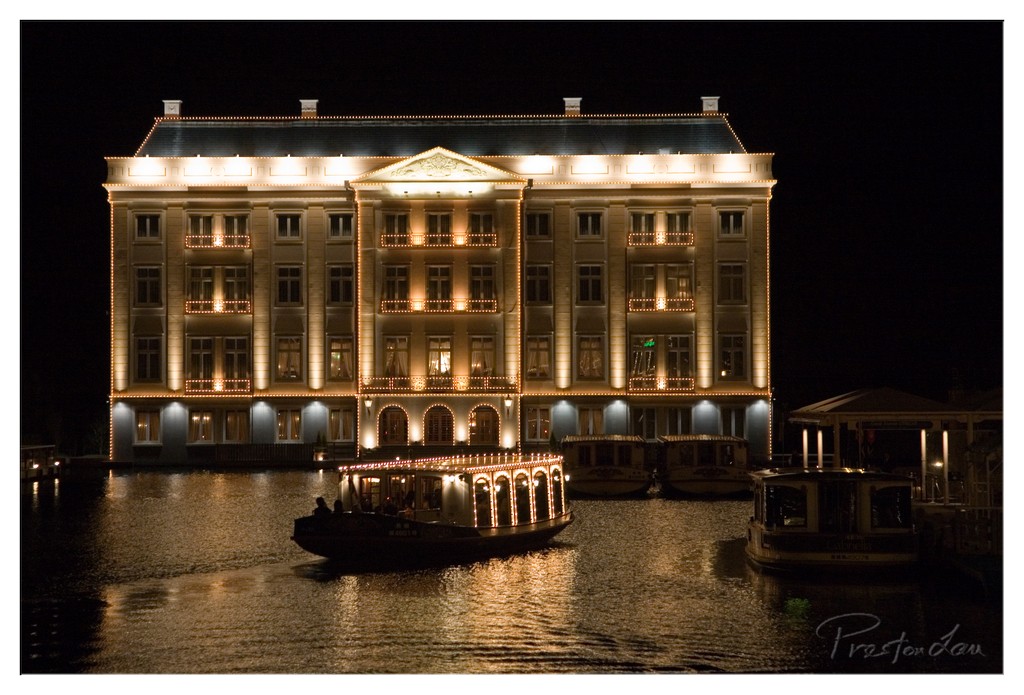

1. Overall Rating (0–10) — 7.5
This photograph captures a serene nocturnal scene where architecture and water converge in a harmonious glow, evoking a sense of quiet elegance. The warm illumination of the grand building and the gently lit boat create a luminous centerpiece, while the dark night sky enhances the drama of the lights. While the image is visually rich and atmospheric, the composition’s symmetry borders on static, slightly diminishing its dynamic appeal.
2. Composition (0–10) — 7.0
The building is centered and dominates the frame, creating a balanced but somewhat rigid structure. The boat in the foreground adds depth and movement, though its placement feels slightly off-center, introducing a subtle asymmetry that disrupts the formal symmetry of the architecture.
3. Lighting (0–10) — 8.5
The use of artificial lighting is masterful—warm, golden strings of lights accentuate the building’s classical details, while reflections on the water amplify the luminous effect. The contrast between the bright façade and the deep black sky creates a dramatic, cinematic mood.
4. Color & Tone (0–10) — 7.5
The palette is dominated by warm yellows and golds, which evoke a cozy, inviting atmosphere. The cool reflections in the water provide a gentle contrast, enhancing the overall tonal harmony. While the color scheme is cohesive, it leans heavily on a single temperature, limiting tonal variety.
5. Creativity (0–10) — 7.0
The image presents a familiar subject—a night view of a lit building—but elevates it through careful lighting and composition. The inclusion of the boat adds a narrative layer, suggesting movement and life within the stillness of the scene.
6. Technical Quality (0–10) — 8.0
The image is sharp and clear, with well-controlled exposure and minimal noise. The focus is consistent across the scene, and the details in both the building and the reflections are rendered with precision.
7. Emotional Impact (0–10) — 8.0
The photograph evokes a sense of calm and wonder, inviting the viewer into a peaceful, almost dreamlike urban night. The interplay of light and water creates a contemplative mood, making the scene feel both intimate and grand.
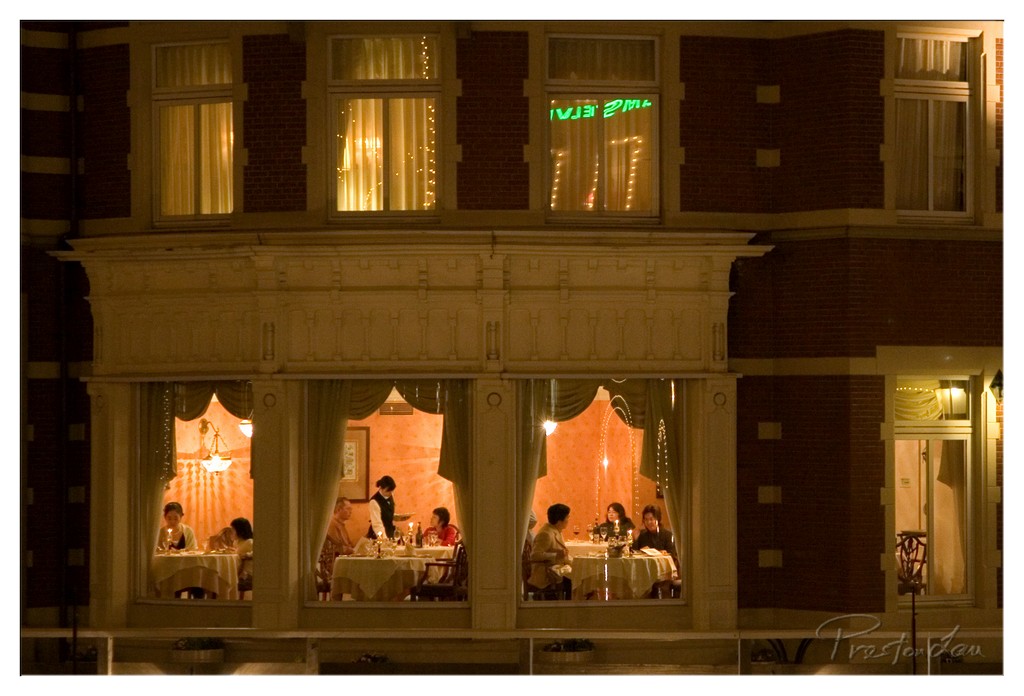

1. Overall Rating (0–10) — 7.5
This photograph captures a quiet, intimate evening at a European-style restaurant, where the warmth of interior light contrasts beautifully with the cool darkness outside. The scene feels both inviting and slightly voyeuristic, drawing the viewer into a private moment of dining and conversation. While the image is visually rich and emotionally resonant, a slightly stronger focal point and tighter composition would elevate its storytelling power.
2. Composition (0–10) — 7.0
The wide framing captures the full facade of the restaurant, but the subject is spread across three large windows, creating a sense of visual fragmentation. The central window, with the most activity, draws the eye, yet the symmetry of the architecture slightly dilutes the emotional focus.
3. Lighting (0–10) — 8.5
The warm, golden glow from within contrasts sharply with the dark night, creating a dramatic and cozy atmosphere. The soft illumination highlights the diners and textures of the interior, while the faint neon sign adds a subtle urban touch.
4. Color & Tone (0–10) — 8.0
A warm, sepia-toned palette dominates, enhancing the nostalgic and intimate mood. The contrast between the golden interior and the cool, dark exterior creates a visually pleasing balance, with the green neon offering a quiet pop of color.
5. Creativity (0–10) — 7.5
The image succeeds in capturing a quiet narrative of urban life—dining, connection, and solitude—through the lens of an observer. The choice to frame the scene from the outside enhances its sense of intimacy and mystery, offering a glimpse into a world that feels both real and distant.
6. Technical Quality (0–10) — 8.0
The image is sharp and well-exposed, with clear detail in both the interior and the architectural elements. The focus is consistent, and the lighting conditions allow for clean rendering without harsh noise or overexposure.
7. Emotional Impact (0–10) — 8.0
There is a strong sense of quiet contemplation and warmth, evoking feelings of comfort and nostalgia. The viewer is invited to wonder about the stories unfolding behind the glass—creating a poignant emotional resonance that lingers.
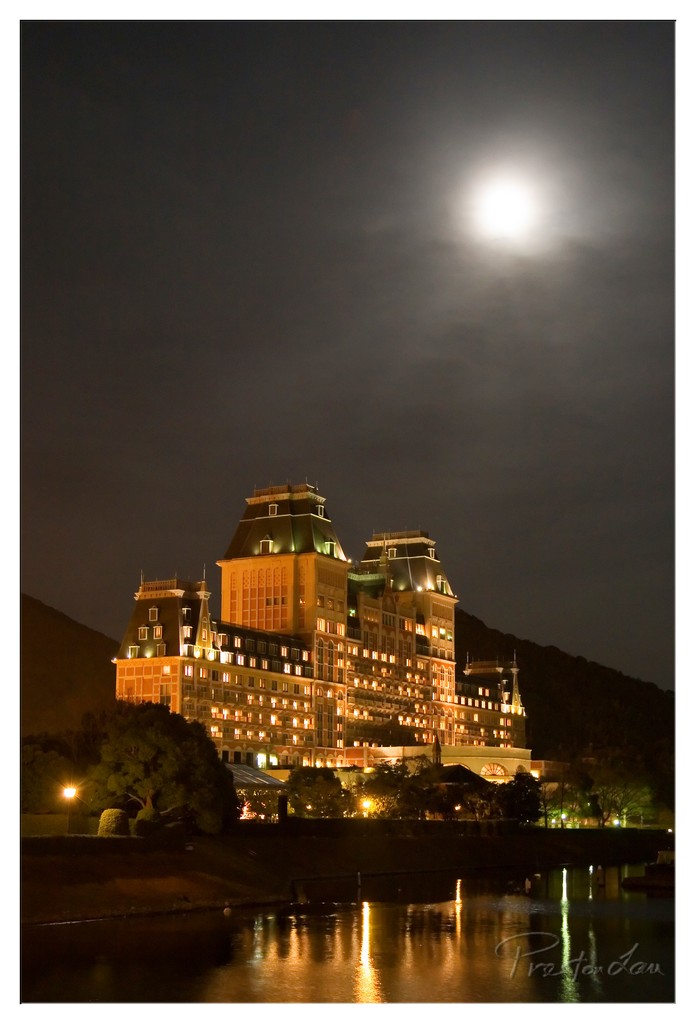

1. Overall Rating (0–10) — 8.0
This photograph captures a majestic, moonlit scene where the grandeur of an illuminated castle-like hotel meets the serene stillness of a reflective waterway. The luminous full moon casts a soft glow over the composition, enhancing the architectural elegance and creating a dreamlike atmosphere. While the image is visually compelling and rich in mood, the slightly overexposed moon and muted foreground details prevent it from achieving complete technical harmony.
2. Composition (0–10) — 7.5
The building is centered and dominates the frame, creating a strong focal point, while the reflection in the water adds symmetry and depth. The inclusion of the moon in the upper right balances the composition, though the dark, underexposed foreground slightly disrupts visual flow.
3. Lighting (0–10) — 8.0
The interplay between the warm artificial lights of the hotel and the cool glow of the moon creates a dramatic contrast. The long exposure captures the smoothness of the water and the steady radiance of the lights, though the moon’s brightness slightly overwhelms the surrounding sky.
4. Color & Tone (0–10) — 7.5
The palette is dominated by warm golds and deep blacks, with the moon providing a stark white highlight. The tonal range is rich and atmospheric, though the lack of vibrant color limits the image’s emotional vibrancy.
5. Creativity (0–10) — 8.0
The combination of architecture, moonlight, and reflection evokes a sense of fantasy and tranquility. The choice to capture the scene at night with a full moon adds a narrative quality, suggesting a timeless, almost cinematic moment.
6. Technical Quality (0–10) — 7.5
The image is sharp and well-focused, with clear details in the building’s facade. The long exposure was executed effectively, though the moon’s overexposure slightly detracts from the overall balance.
7. Emotional Impact (0–10) — 8.5
The image evokes a deep sense of peace and wonder, drawing the viewer into a quiet, magical world. The combination of light, water, and architecture creates a powerful emotional resonance, suggesting solitude and beauty in the stillness of night.
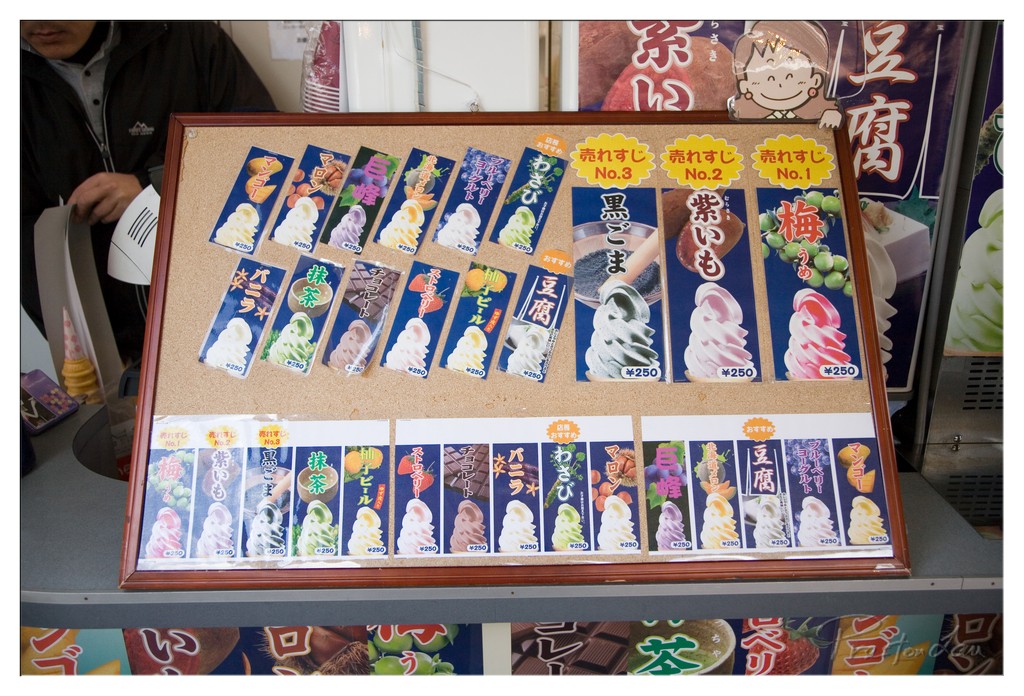

1. Overall Rating (0–10) — 5.5
This photograph captures a vibrant, everyday scene at a Japanese ice cream stand, where the colorful menu cards convey a sense of playful variety and local charm. While the composition is cluttered and the lighting flat, the image succeeds in documenting a slice of street culture with candid authenticity. The lack of visual refinement keeps it from feeling like a deliberate artistic statement, but its observational honesty gives it a modest appeal.
2. Composition (0–10) — 4.5
The frame is crowded and uneven, with the menu board dominating the center but lacking a clear focal point. The partial figure on the left and the overlapping signage create visual noise, diminishing the clarity of the subject.
3. Lighting (0–10) — 5.0
The lighting is bright but flat and unmodulated, likely from overhead fluorescent sources, which washes out color and detail. The reflections on the board’s glass surface further reduce visibility and depth.
4. Color & Tone (0–10) — 6.0
The palette is lively, with bold blues, reds, and greens in the menu cards, but the colors appear slightly oversaturated and inconsistent due to lighting. The overall tone is more commercial than artistic, with a lack of tonal harmony.
5. Creativity (0–10) — 5.0
The image feels more like a documentation than a creative interpretation. While the subject has inherent visual interest, the execution lacks a distinctive perspective or emotional narrative.
6. Technical Quality (0–10) — 6.5
The focus is sharp on the menu board, and the detail in the printed text and images is clear. However, the composition and lighting detract from the overall technical polish.
7. Emotional Impact (0–10) — 5.0
The image evokes a sense of familiarity and mild nostalgia, particularly for those who have visited similar street vendors in Japan. However, the emotional connection is restrained by the impersonal and cluttered presentation.
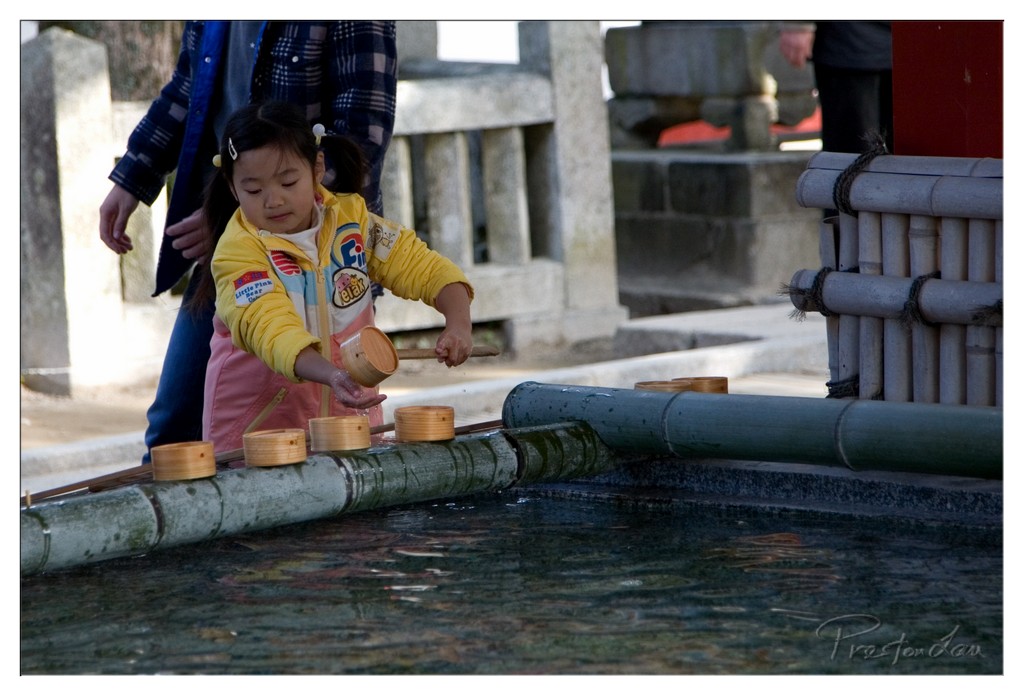

1. Overall Rating (0–10) — 7.5
This photograph captures a tender moment of cultural ritual, where a young girl participates in a traditional purification practice with quiet focus and innocence. The interplay of natural light and the serene setting evokes a sense of reverence and timelessness, though the composition’s slight awkwardness keeps it from achieving full visual harmony. The image succeeds in conveying both the sacredness of the act and the quiet charm of childhood participation.
2. Composition (0–10) — 6.0
The subject is well-placed but slightly off-center, and the cluttered background and foreground elements—particularly the bamboo railing and the figure in the back—distract from the central moment. A tighter crop and better framing would enhance focus on the girl’s gesture.
3. Lighting (0–10) — 7.0
Natural daylight illuminates the scene evenly, casting soft shadows that add depth without overpowering the subject. The highlights on the water and the girl’s face are well-balanced, preserving detail and warmth.
4. Color & Tone (0–10) — 7.0
The palette is subdued yet harmonious, with earthy tones of bamboo and stone complemented by the girl’s bright yellow jacket. The contrast between the vibrant clothing and the muted surroundings draws the eye naturally to the subject.
5. Creativity (0–10) — 7.5
The image captures a culturally rich moment with authenticity and emotional nuance. The candidness of the gesture and the inclusion of the surrounding environment lend a narrative quality, transforming a simple act into a story of tradition and continuity.
6. Technical Quality (0–10) — 8.0
Sharp focus on the girl and her hands, clear detail in the water and bamboo, and a well-handled exposure indicate strong technical execution. The watermark is subtle and does not detract from the image.
7. Emotional Impact (0–10) — 8.0
The photograph resonates with quiet dignity and innocence, evoking a sense of connection to heritage and ritual. The viewer is invited into a moment of peaceful participation, making the emotional impact both gentle and lasting.
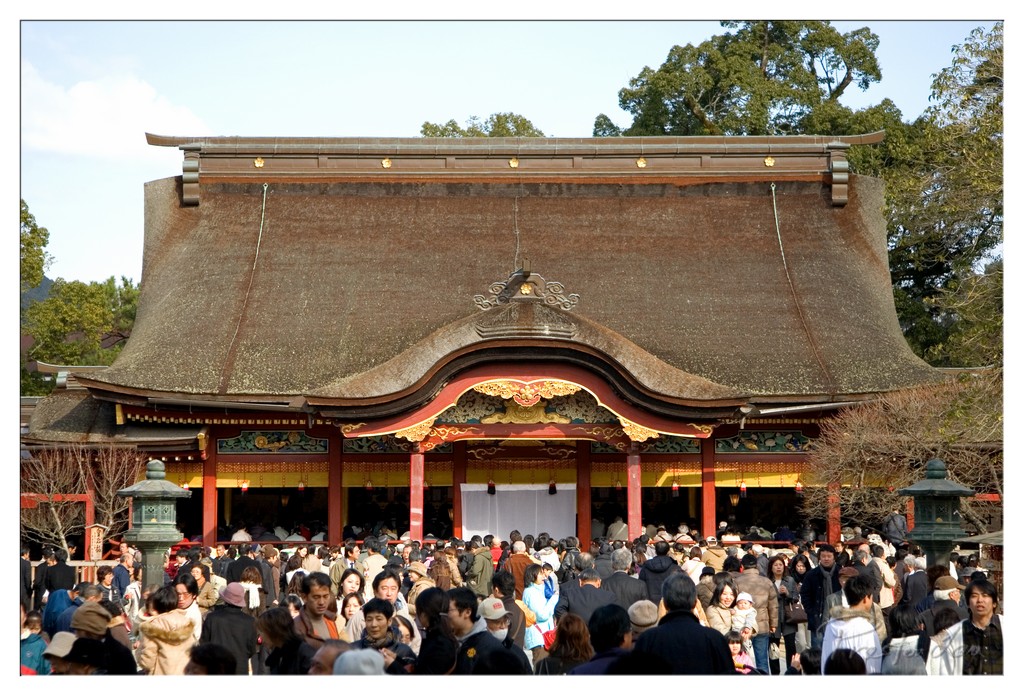

1. Overall Rating (0–10) — 7.0
This photograph captures the vibrant energy of a bustling shrine, where tradition and community converge in a single frame. The grandeur of the thatched roof and ornate entrance contrasts beautifully with the dense crowd below, creating a dynamic tension between stillness and motion. While the image effectively conveys the scale and cultural significance of the location, a slightly more deliberate framing could elevate its visual narrative beyond mere documentation.
2. Composition (0–10) — 6.5
The central placement of the shrine balances the frame, but the crowded foreground creates visual clutter. A tighter crop or slight shift in perspective could better guide the eye toward the architectural details.
3. Lighting (0–10) — 7.0
Natural daylight illuminates the scene evenly, highlighting the textures of the thatch and the vivid colors of the shrine’s facade. The soft shadows add depth without overpowering the composition.
4. Color & Tone (0–10) — 7.5
The warm reds and golds of the shrine contrast strikingly with the muted tones of the crowd and the greenery, creating a rich, layered palette. The overall tone feels authentic and harmonious, reflecting the scene’s cultural context.
5. Creativity (0–10) — 6.5
The image captures a compelling cultural moment with clarity and respect, but it leans more toward documentary than artistic interpretation. The concept is strong, but the execution remains conventional.
6. Technical Quality (0–10) — 8.0
Sharp focus and clean detail across the frame, with no visible noise or distortion. The exposure is well-balanced, preserving detail in both highlights and shadows.
7. Emotional Impact (0–10) — 6.0
The image evokes a sense of communal reverence and cultural continuity, though the sheer number of people slightly dilutes the intimacy of the moment. It invites reflection on tradition, but doesn’t deeply stir personal emotion.
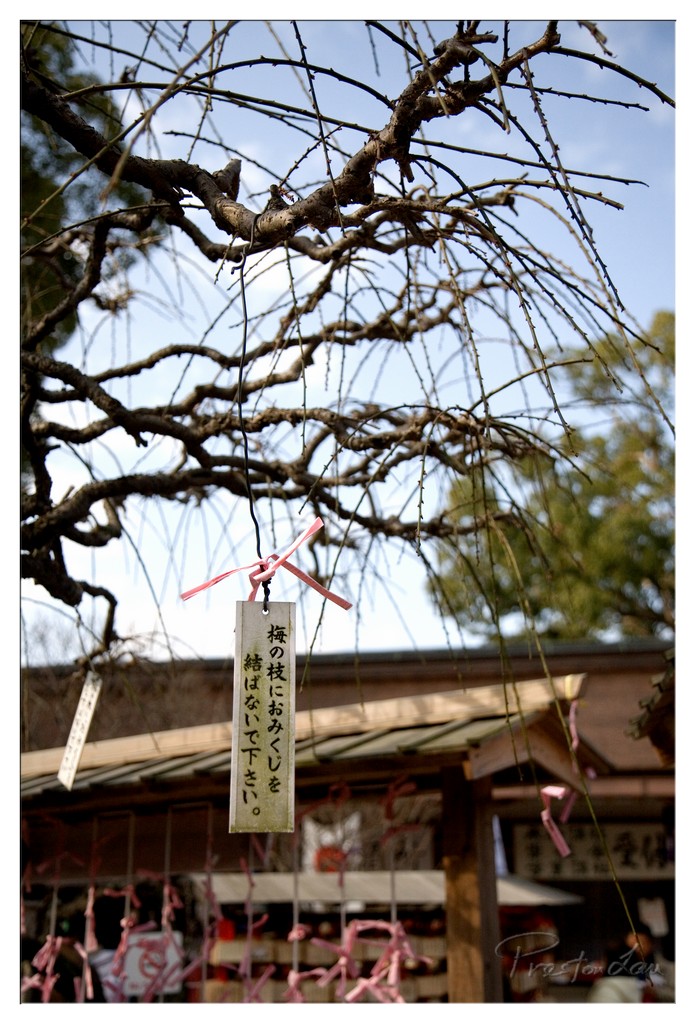

1. Overall Rating (0–10) — 7.0
This photograph captures a quiet, contemplative moment at a Japanese shrine, where tradition and nature intertwine in delicate harmony. The weathered branches and handwritten prayer tag evoke a sense of timelessness and spiritual reflection, while the soft focus and natural light lend a dreamy, almost meditative quality. While the image is rich in cultural nuance, its emotional resonance is slightly muted by a lack of visual contrast and dynamic tension.
2. Composition (0–10) — 6.5
The diagonal sweep of the branches creates a natural leading line, guiding the eye toward the prayer tag, which serves as the focal point. However, the shallow depth of field, while intentional, results in a cluttered background that competes for attention, slightly undermining the image’s clarity and compositional balance.
3. Lighting (0–10) — 7.0
Soft, diffused daylight enhances the natural textures of the bare branches and the aged paper of the tag, creating a gentle, even illumination that supports the serene mood. The subtle shadows lend depth without harshness, though the overall exposure is slightly underexposed, muting the vibrancy of the sky.
4. Color & Tone (0–10) — 6.5
The muted palette of browns, grays, and pale pinks creates a subdued, contemplative tone, consistent with the image’s cultural and spiritual context. The soft pink ribbons provide a gentle contrast, but the overall lack of saturation reduces visual impact, lending the scene a slightly flat appearance.
5. Creativity (0–10) — 7.5
The combination of natural elements with human-made prayer tags offers a poignant narrative of devotion and connection. The choice to focus on a single tag amidst the organic chaos of the branches is both poetic and culturally resonant, reflecting a quiet, personal moment within a broader tradition.
6. Technical Quality (0–10) — 7.0
The image is sharp on the prayer tag, with good detail in the text and texture of the wood. The focus is precise, and the depth of field is well-controlled, though the background blur is so extensive that it risks obscuring contextual elements. The exposure is slightly low, affecting tonal range.
7. Emotional Impact (0–10) — 7.0
The image evokes a sense of peace and introspection, inviting the viewer to reflect on the quiet rituals of faith and hope. The handwritten message, though unreadable without translation, adds an intimate layer of personal meaning, creating a subtle but meaningful emotional connection.
Loading map...